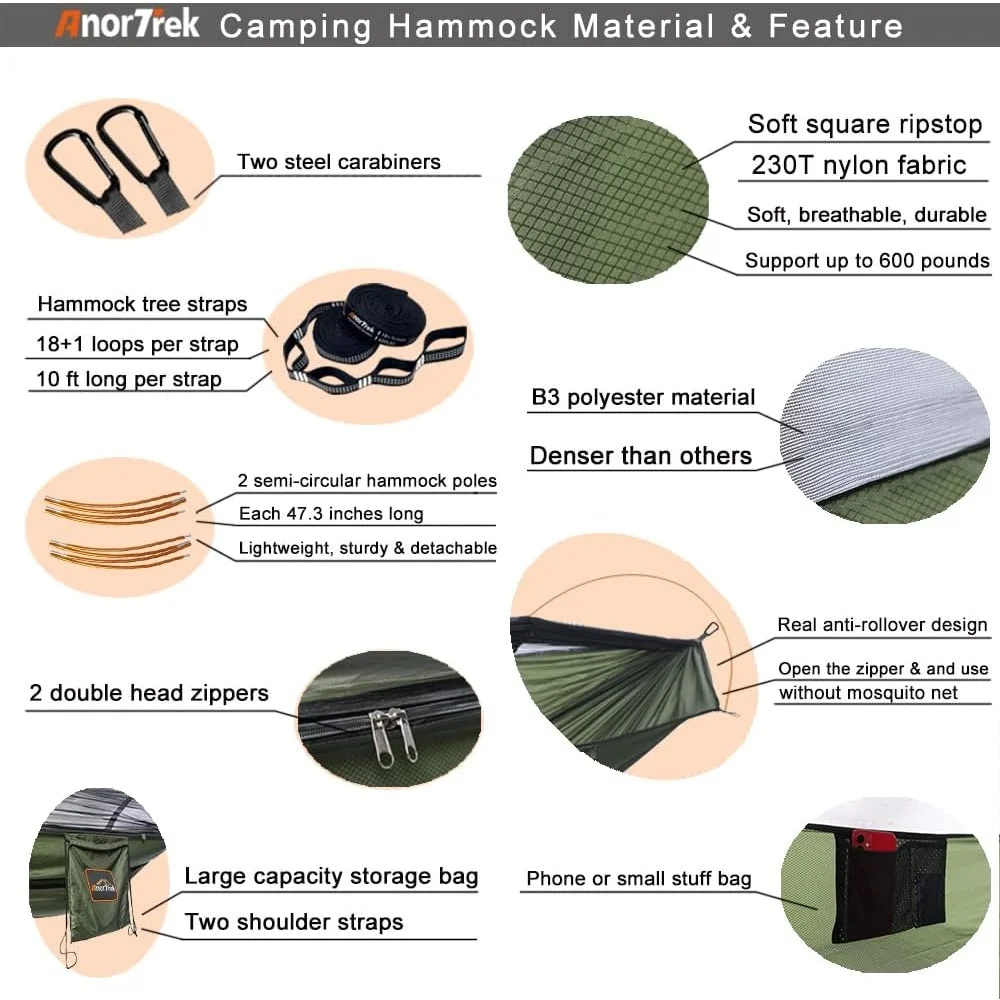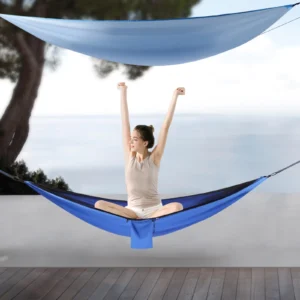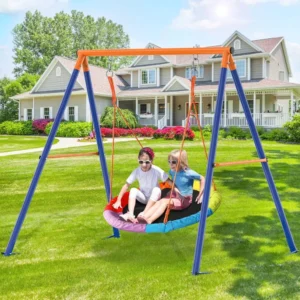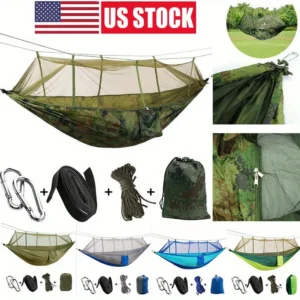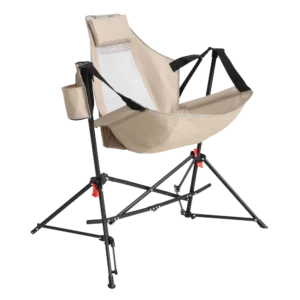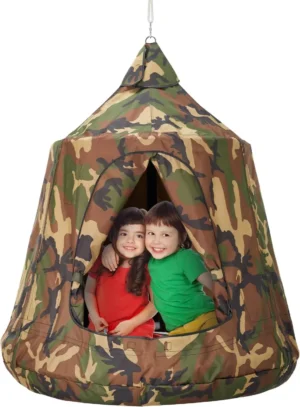Why Choose Ultralight Hammock Camping? Key Advantages and Considerations
Ultralight hammock backpacking refers to a minimalist approach to hammock camping where your base weight (all gear excluding consumables like food and water) stays under 10 pounds (4.5kg). This increasingly popular approach offers several distinct advantages over traditional tent camping.
The primary benefit of hammock backpacking is significantly reduced pack weight. A complete ultralight hammock system typically weighs 2-3 pounds (0.9-1.4kg), compared to lightweight tents at 3-5 pounds (1.4-2.3kg). This weight reduction makes a noticeable difference on long trails and challenging terrain.
Key advantages include:
– Superior comfort on uneven, rocky, or sloped terrain where finding flat ground is difficult
– Elevated sleeping position away from ground moisture, rocks, and crawling insects
– Minimal environmental impact with no need to clear or flatten ground
– Better airflow around your body, reducing condensation issues
– Often faster setup and breakdown times once you master the techniques
However, several considerations should be noted:
– Tree dependency limits camping options in treeless environments
– Learning curve for proper setup, especially for insulation systems
– Specific skills needed for staying warm due to increased airflow underneath
The key benefits of ultralight hammock backpacking center around freedom and mobility while maintaining comfort. With proper initial hammock setup principles, you’ll find yourself enjoying terrain that tent campers simply can’t access.
Essential Ultralight Hammock Components: Building Your Lightweight System
Creating an effective ultralight hammock system requires careful selection of each component to balance weight, functionality, and comfort. Here’s what you’ll need for a complete setup:
Hammock Body
The foundation of your system is the hammock itself. For ultralight setups, focus on:
- Materials: Look for lightweight ripstop nylon between 1.0-1.7oz/yd² (specialized ultralight fabrics can weigh as little as 0.8oz/yd²)
- Length: 11 feet (3.35m) hammocks offer the best balance of comfort and weight for most adults
- Construction: Single layer designs save weight (around 10-14oz/283-397g) but double layers (16-20oz/453-567g) provide more durability and can create a sleeve for a sleeping pad
Suspension Systems
Your connection to trees should be both lightweight and safe:
- Dyneema whoopie slings weigh just 0.5oz (14g) per side while providing adjustability
- Tree straps should be at least 1 inch (2.5cm) wide to protect tree bark (4-5oz/113-142g total)
- Titanium or aluminum buckles and toggles save weight over steel hardware
- Complete ultralight suspension systems typically weigh 3-6oz (85-170g) total
Weather Protection
A minimalist but effective tarp is essential:
- Catenary-cut (curved edge) designs save weight while maintaining coverage
- Materials like Dyneema Composite Fabric (DCF) weigh 7-8oz (200-226g) for full coverage
- Silpoly tarps offer good value at 9-12oz (255-340g)
- Diamond shapes are lightest (5-7oz/142-198g) but rectangular or hexagonal shapes provide better coverage in harsh conditions
Insulation Essentials
Proper insulation is critical for hammock camping:
- Underquilts with 800+ fill power down provide the best warmth-to-weight ratio (12-16oz/340-453g for 3-season use)
- Synthetic underquilts weigh more (16-20oz/453-567g) but perform better when wet
- Top quilts save 30-40% weight compared to sleeping bags with similar temperature ratings
Bug Protection
Depending on your environment, you’ll need:
- Integrated bug nets add 4-6oz (113-170g) to hammock weight
- Separate bug nets offer more versatility at 6-10oz (170-283g)
- Some ultralight setups use head nets and bug repellent to save weight in less buggy conditions
Each component must be selected carefully to create a harmonious system. For instance, essential bug protection components work together with your hammock and tarp to create a secure shelter. Understanding how to elevate sleep with lightweight hammock camping techniques will help you make informed gear choices.
Selecting the Right Hammock: Size, Material, and Weight Considerations
Choosing the optimal hammock requires balancing several key factors. The right hammock forms the foundation of your ultralight system, making this decision particularly important.
Hammock length significantly impacts comfort and weight. While 10-foot (3m) hammocks save weight (typically 8-10oz/227-283g), 11-foot (3.35m) options (10-12oz/283-340g) provide better diagonal lay positioning for most adults. Taller individuals might prefer 12-foot (3.66m) hammocks (12-14oz/340-397g) despite the weight penalty.
Material selection greatly affects both durability and pack weight:
| Material Type | Weight (oz/yd²) | Durability | Best Use |
|---|---|---|---|
| 1.0 Nylon | 10-12oz total | Moderate | Summer, ultralight priority |
| 1.2-1.7 Nylon | 12-16oz total | Good | 3-season, balanced approach |
| DCF Hybrid | 8-10oz total | Moderate | Extreme ultralight |
| Double Layer | +4-6oz total | Excellent | Rough conditions, heavier users |
Consider your body size and sleeping style when selecting hammock dimensions. An average adult needs about 8 feet (2.4m) of effective flat space for comfortable diagonal positioning in an 11-foot hammock. Wider hammocks (5-6ft/1.5-1.8m) allow for better diagonal positioning but add 2-3oz (57-85g) over standard widths.
Weight capacity is another critical consideration. Most ultralight hammocks support 250-300lbs (113-136kg), which works for most users. If you’re heavier or carrying substantial gear, look for reinforced designs or double-layer hammocks rated for 350-400lbs (159-181kg).
Exploring different lightweight hammock options can help you understand the range of choices available. For more detailed information on materials and design features, you might want to explore our ultimate guide to ultralight hammock features.
Ultralight Suspension Systems: Minimizing Weight Without Sacrificing Safety
Your suspension system connects your hammock to trees, making it a critical component that must balance minimal weight with maximum safety. The lightest options can save you 4-8 ounces (113-227g) over standard suspension systems.
Ultralight Suspension Options by Weight:
- Dyneema Whoopie Slings: 0.5oz (14g) per side, adjustable, and incredibly strong for their weight
- Kevlar Tree Straps: 1.5-2oz (42-57g) per side, offering excellent strength with minimal stretch
- Webbing with Becket Hitch: 2oz (57g) per side, simple and requiring no additional hardware
Despite the ultralight focus, never compromise on tree protection. Always use tree straps at least 1 inch (2.5cm) wide to distribute pressure and prevent damage to bark. Narrower cordage or straps can cut into and damage trees.
Setting Up Ultralight Suspension:
- Place tree straps around trees at eye level, about 12-15 feet (3.7-4.6m) apart
- Attach your suspension system (whoopie slings or webbing) to the straps
- Connect your hammock to the suspension using lightweight hardware or knots
- Adjust to achieve a 30° angle from horizontal for optimal weight distribution
- Verify your lay height is approximately 18 inches (46cm) off the ground when weighted
For even more weight savings, consider multi-use items. Trekking pole straps can double as part of your suspension system, saving 1-2oz (28-57g). Some hikers even use their bear bag line as part of their ridgeline setup.
For additional information on effective suspension systems that minimize both weight and environmental impact, explore our collection of camping hammocks and stands.
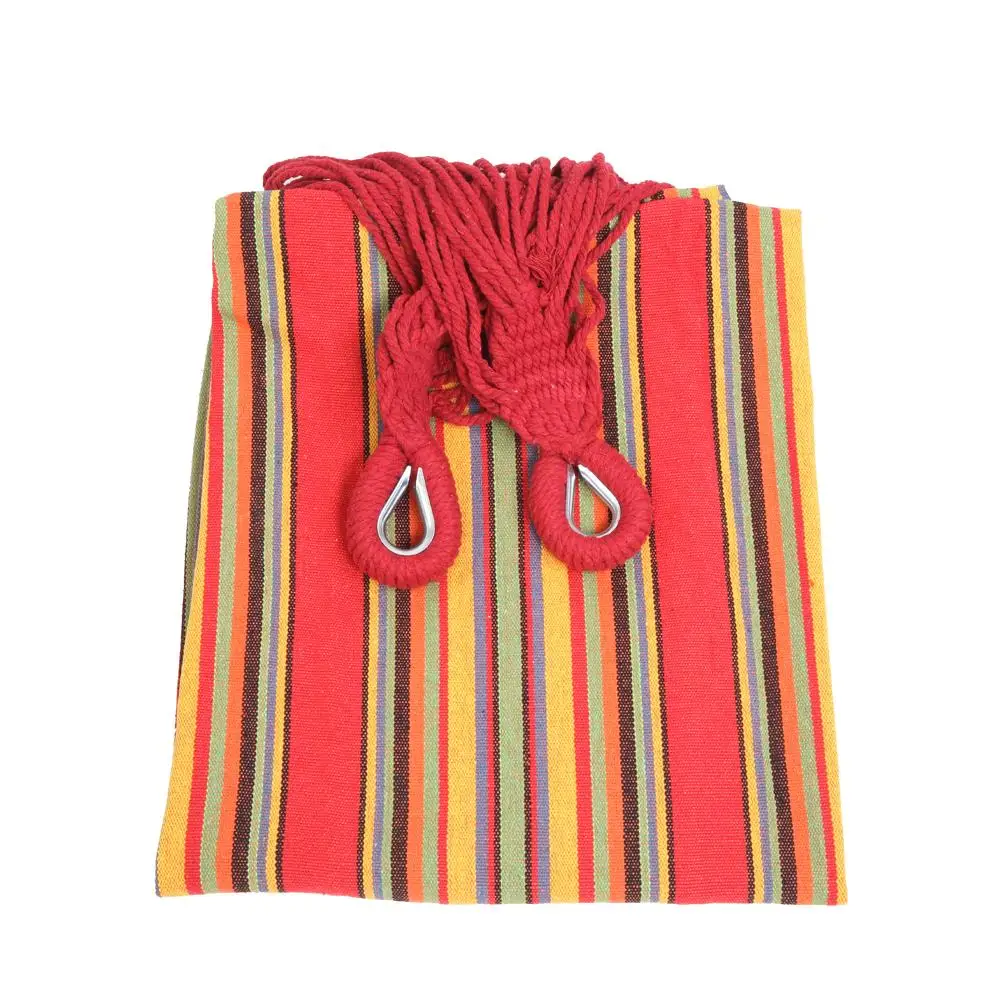
Lightweight Weather Protection: Tarp Selection and Setup
Effective weather protection is essential for hammock camping, but traditional tarps can add significant weight. Choosing the right ultralight tarp and setting it up efficiently helps maintain weather security while keeping your pack light.
Ultralight Tarp Shapes:
- Diamond: The lightest option (5-7oz/142-198g), providing minimal coverage suitable for fair weather
- Hexagonal: Balanced coverage-to-weight ratio (7-9oz/198-255g), versatile for most conditions
- Rectangular: Maximum coverage (9-12oz/255-340g), best for extended poor weather
Material Comparison:
- Dyneema Composite Fabric (DCF): Lightest option (7oz/198g for hex shape), waterproof without seam sealing, but expensive
- Silpoly: Good weight-to-performance ratio (9oz/255g for hex shape), minimal stretch when wet
- Silnylon: Budget-friendly (10oz/283g for hex shape), but stretches when wet requiring readjustment
For most 3-season conditions, an 8ft×10ft (2.4m×3m) tarp provides adequate coverage while keeping weight down. To further minimize weight, use 1.5mm Dyneema cord for guylines (saving 1-2oz/28-57g over standard cordage) and titanium shepherd hooks (0.2oz/6g each) instead of heavier stakes.
Setting up your tarp ridgeline first ensures proper positioning over your hammock. For the lightest approach, use the same line that connects your tree straps rather than a separate dedicated ridgeline. Adjust your tarp height based on weather conditions:
- Higher pitch (7-8ft/2.1-2.4m): Better airflow in good weather
- Lower pitch (5-6ft/1.5-1.8m): Better rain and wind protection
- Asymmetric pitch: Concentrated coverage where needed, saving weight with smaller tarps
For weather protection that integrates seamlessly with your hammock system, explore our complete camping hammock systems that feature carefully matched components.
Hammock Insulation Strategies: Defeating Cold Butt Syndrome
One of the biggest challenges in hammock camping is staying warm. Unlike ground sleepers who only lose heat in one direction, hammock campers experience convective heat loss from air circulating underneath their bodies. This phenomenon, often called “Cold Butt Syndrome,” can make you cold even in mild temperatures.
Insulation Options by Weight and Effectiveness:
Underquilts:
– Provide insulation by hanging beneath your hammock
– Most efficient solution as they don’t compress under your weight
– 3/4 length (covering shoulders to knees) weighs 10-12oz (283-340g) for summer ratings
– Full-length adds 4-6oz (113-170g) but provides complete coverage
– Down fill (800+ fill power) offers best warmth-to-weight ratio
Sleeping Pads:
– Lighter option (6-10oz/170-283g) but less comfortable
– Tend to shift during the night
– Provide a firm sleeping surface, which negates some hammock comfort
– Foam pads are lighter but bulkier; inflatable pads are more compact but heavier
Insulation Material Comparison:
– Down insulation: Lightweight (12oz/340g for 40°F/4°C rating), compressible, but loses insulation when wet
– Synthetic: Heavier (16oz/453g for similar rating), bulkier, but insulates when damp
For maximum weight savings, consider a 3/4 length underquilt paired with a small sit pad for your feet or clothing stuffed into your foot end. This hybrid approach can save 3-4oz (85-113g) over a full-length underquilt while maintaining warmth.
Temperature ratings should be selected based on your expected conditions, but many ultralight backpackers choose gear rated 10°F (6°C) below their anticipated lowest temperature to provide a safety margin.
For organizing your insulation systems efficiently, our guide to lightweight hammock gear organization offers practical tips that keep critical warmth-generating components readily accessible.
Advanced Techniques for Maximum Comfort at Minimum Weight
Achieving comfort in a hammock doesn’t require heavy gear—it’s primarily about technique. Mastering these advanced methods will maximize your comfort while maintaining ultralight principles.
Diagonal Lay Technique
The key to comfortable hammock sleeping is laying diagonally across the centerline at roughly a 30° angle. This flattens your body position by:
– Spreading your weight across more of the hammock fabric
– Reducing the curve that causes your knees to hyperextend
– Creating a flatter surface for your back and shoulders
Structural Ridgeline Optimization
A structural ridgeline maintains consistent hammock sag regardless of hanging distance:
– Set length at 83% of your hammock’s total length (e.g., 109 inches/277cm for an 11-foot/335cm hammock)
– Use 1.75mm Dyneema cord weighing just 0.5oz (14g) for the entire ridgeline
– This ensures proper sag every time without adjustment
Asymmetric Positioning
Taking advantage of your hammock’s natural shape:
– Position your upper body slightly left or right of center
– Place feet in the opposite direction
– This creates more shoulder and foot room within the same hammock dimensions
– Most comfortable when your body forms a shallow “S” shape
Using Existing Gear as Pillows
Instead of carrying a dedicated pillow:
– Stuff your jacket or extra clothing into your hammock stuff sack
– Place your soft pack items (like a puffy jacket) in a dry bag
– Use your food bag wrapped in a soft layer
For optimal comfort, hang your hammock with a bottom height of 18 inches (46cm) when weighted and ensure your suspension forms 30° angles with the trees. This provides the ideal amount of sag for comfortable diagonal sleeping.
Learning to maintain gear longevity while preserving comfort is essential for ultralight backpackers. Our guide to lightweight hammock durability for outdoor adventures provides additional techniques for maximizing both comfort and gear lifespan.
Ultralight Packing Strategies for Hammock Systems
Efficient packing is essential for ultralight hammock backpacking. Proper techniques not only save space but also protect your gear and maintain convenient access to essential items.
Compression Techniques for Down Insulation
Down underquilts and top quilts require special handling:
– Store loosely when not in use to preserve loft
– When packing, gently compress in stages rather than forcing
– Use waterproof compression sacks sized 2-3 liters larger than minimum volume
– Stuff from bottom to top, allowing air to escape gradually
– Compress only as much as needed—over-compression damages down fibers
Strategic Packing Order
Organize your backpack for weight distribution and accessibility:
– Place hammock and suspension near the top for quick access at camp
– Position underquilt and tarp in waterproof bags regardless of weather
– Keep rain gear and essentials in exterior pockets for immediate access
– Use the center of your pack for heavier items like food
– A properly packed ultralight hammock system occupies roughly 6×8 inches (15×20cm) of space
Weather-Conscious Packing
Separate your gear into dry and potentially wet items:
– Pack tarp separately from hammock since it may be wet from dew
– Use waterproof stuff sacks for insulation even inside a waterproof pack
– Keep a dry bag accessible for electronics and fire-starting materials
For maximum efficiency, use dual-purpose stuff sacks. Your hammock stuff sack can double as a pillowcase, and your underquilt stuff sack can serve as a small day pack or water collection bag.
For more specific techniques on efficient hammock packing, our guides on how to pack a hammock for hiking and advanced hammock compression techniques offer detailed advice for minimizing volume while protecting your gear.
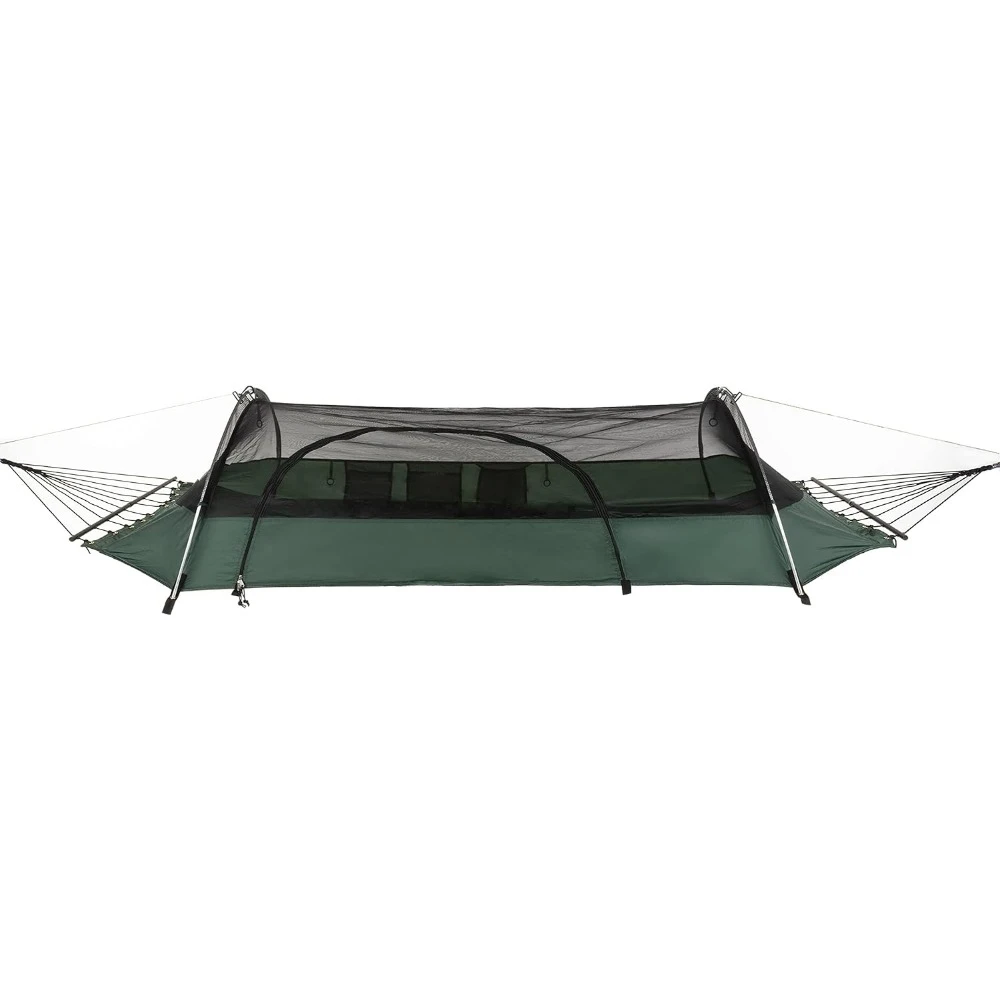
Site Selection and Setup Efficiency for Hammock Camping
Finding the ideal hammock site differs significantly from tent site selection. The right location enhances both comfort and safety while minimizing your environmental impact.
Identifying Optimal Hanging Trees
Look for these characteristics:
– Healthy, living trees at least 8 inches (20cm) in diameter
– Spacing between 12-15 feet (3.7-4.6m) apart
– Free from dead branches overhead (“widow makers”)
– No signs of disease, splitting, or weakness
– Preferably with bark that isn’t easily damaged
Environmental Considerations
Strategic positioning improves comfort and safety:
– Identify natural windbreaks like dense vegetation or terrain features
– Select locations with good drainage in case of rain
– Position your hammock perpendicular to prevailing winds
– Look for partial overhead coverage to reduce dew formation
– Maintain Leave No Trace principles by avoiding impact to vegetation
Quick Setup Sequence
With practice, an efficient setup should take under 5 minutes:
1. Identify suitable trees and assess overhead hazards
2. Place tree straps at sitting height (about 4 feet/1.2m high)
3. Attach suspension system and hang hammock loosely
4. Install structural ridgeline if using one
5. Set up tarp over hammock, centered and appropriate for conditions
6. Adjust hammock to final height and tension
7. Add underquilt, bug protection, and top insulation
Site Assessment Checklist
- Tree health and stability ✓
- Proper spacing between trees ✓
- Clear of ground hazards (sharp rocks, ant hills, poison ivy) ✓
- Protected from wind when possible ✓
- No dead branches overhead ✓
- Minimal impact on vegetation ✓
For systems designed for rapid deployment in various environments, consider exploring our quick setup hammock sets that feature intuitive connection points and simplified adjustment mechanisms.
Camping Hammock Sets with Bug Net, Ultralight Camping Hammock Sets
$139.72 Select options This product has multiple variants. The options may be chosen on the product pageFolding Hammock Sets, Quick Setup Hammock Sets
Price range: $305.52 through $583.27 Select options This product has multiple variants. The options may be chosen on the product pageCamping Hammock Sets with Bug Net, Complete Camping Hammock Systems
Price range: $82.73 through $97.96 Select options This product has multiple variants. The options may be chosen on the product pageFolding Hammock Sets, Lightweight Hammock Sets
$295.80 Select options This product has multiple variants. The options may be chosen on the product pageComplete Camping Hammock Systems, Hanging Egg Chair Sets
$266.73 Select options This product has multiple variants. The options may be chosen on the product page
Troubleshooting Common Ultralight Hammock Issues
Even experienced hammock campers encounter challenges. Here are solutions to the most common problems faced with ultralight hammock systems:
Q: Why am I experiencing cold spots despite using an underquilt?
A: Cold spots typically result from improper underquilt positioning or inadequate suspension. Ensure your underquilt:
– Wraps around the sides of your hammock completely
– Is adjusted to eliminate air gaps, especially at the shoulders and feet
– Has enough tension in its suspension to stay against your hammock
– Consider adding shock cord to your underquilt suspension to maintain contact as you move
Q: How do I deal with insufficient tarp coverage during unexpected rain?
A: When facing heavier rain than anticipated:
– Lower your tarp closer to your hammock on all sides
– Pitch ends lower than the sides for better protection
– Use natural features like dense foliage for additional protection
– Deploy emergency options like a poncho over your hammock ends
– Position yourself diagonally to stay away from potentially exposed edges
Q: What causes instability or an uncomfortable hang?
A: Unstable hammocks are usually the result of:
– Incorrect hanging angle (aim for 30° from horizontal)
– Uneven suspension heights between trees
– Structural ridgeline that’s too tight or too loose (should be 83% of hammock length)
– Improperly positioned body weight (try lying diagonally)
Q: How can I improve bug protection in an ultralight setup?
A: If bugs are penetrating your defenses:
– Check for holes in netting or gaps in coverage
– Treat your hammock and surroundings with permethrin (not while occupied)
– Use head nets combined with long clothing if you’ve opted for a no-net ultralight setup
– Consider carrying an emergency lightweight bug net (2-3oz/57-85g) during bug season
Q: What if I can’t find suitably spaced trees?
A: When faced with limited hanging options:
– Look for alternative anchor points like large boulders, fence posts, or vehicle racks
– Carry lightweight hammock hardware that extends your reach between trees
– In emergencies, set up your hammock tarp as a ground shelter
For more insights on hammock options that address these common issues, explore our selection of backpacking hammocks designed to overcome typical challenges.
Multi-Use Gear Strategies to Further Reduce Weight
The ultralight philosophy extends beyond choosing lightweight gear to using items for multiple purposes. This approach can significantly reduce your base weight without sacrificing functionality.
Trekking Poles as Structural Supports
- Use trekking poles to support your tarp in porch mode
- Creates additional covered living space while saving 2-3oz (57-85g) on dedicated poles
- Can serve as emergency hammock supports with specialized adapters
Clothing as Supplemental Insulation
- Stuff jacket or extra clothes between your back and the hammock for added insulation
- Layer clothes around your shoulders inside the hammock
- Use down jacket as a top quilt in mild temperatures, saving 8-14oz (227-397g)
Food Storage as Comfort Items
- Bear bag or food sack doubles as a pillow when wrapped in soft clothing
- Stuff sack for food can become an organizing pouch during the day
- Hard-sided food containers can serve as small camp stools
Water Systems as Thermal Regulators
- Water bottles filled with hot water add warmth to underquilt in cold weather
- Hydration bladder can be positioned for back insulation
- Water bottles can stabilize tarp corners in windy conditions
Other Multi-Use Examples:
- Bandana serves as pot holder, filter, towel, and emergency first aid item
- Hammock stuff sack becomes a pillowcase at night
- Tarp doubles as ground cloth for cooking and socializing
- Underquilt stuff sack works as a water collection device
By implementing these strategies, you might reduce your pack weight by 1-2 pounds (0.45-0.9kg) compared to carrying single-purpose items. For more ideas on integrating hammocks with multi-purpose gear, our backpacking compact hammock guide offers additional strategies for maximizing gear efficiency.
Seasonal Adaptations for Ultralight Hammock Systems
Your hammock system should adapt to seasonal conditions while maintaining ultralight principles. Each season presents unique challenges and opportunities for weight optimization.
Seasonal Comparison Table
| Season | Base Weight | Key Components | Temperature Focus |
|---|---|---|---|
| Summer | 4-6 lbs (1.8-2.7kg) | Hammock, lightweight tarp, bug net | Ventilation and insect protection |
| Spring/Fall | 6-8 lbs (2.7-3.6kg) | + Underquilt, medium tarp | Adaptable insulation for varying temps |
| Winter | 8-10 lbs (3.6-4.5kg) | + Full coverage tarp, heavier insulation | Comprehensive weather protection |
Summer Setup (40-70°F/4-21°C)
- Ultralight 1.0oz/yd² hammock body (8-10oz/227-283g total)
- Minimal diamond tarp (5-7oz/142-198g)
- Bug protection emphasis (integrated or separate net)
- Light 40-50°F (4-10°C) top quilt or sleeping bag liner
- Minimal or no underquilt in warm conditions
- Focus on ventilation and moisture management
Spring/Fall Setup (30-60°F/-1-15°C)
- Standard 1.2-1.7oz/yd² hammock for durability (10-14oz/283-397g)
- Hex or rectangular tarp for better coverage (8-10oz/227-283g)
- Modular insulation system:
- 3/4 length 30-40°F (-1 to 4°C) underquilt (12-14oz/340-397g)
- Supplemental foot pad for colder nights (2oz/57g)
- 30°F (-1°C) top quilt with foot box (16-20oz/453-567g)
- Adjustable ventilation options
Winter Setup (below 30°F/-1°C)
- Durable 1.7oz/yd² hammock, possibly double layer (14-18oz/397-510g)
- Full-coverage winter tarp with doors (12-16oz/340-453g)
- Full-length 0-20°F (-18 to -7°C) underquilt (18-22oz/510-624g)
- Matching top quilt or sleeping bag (22-28oz/624-794g)
- Dedicated insulated hood or balaclava
- Supplemental reflective materials
The key to seasonal adaptation is modular components. By swapping individual pieces rather than entire systems, you maintain ultralight principles while adapting to conditions. For example, exchanging a summer underquilt for a winter version adds only 6-8oz (170-227g) versus carrying a completely separate system.
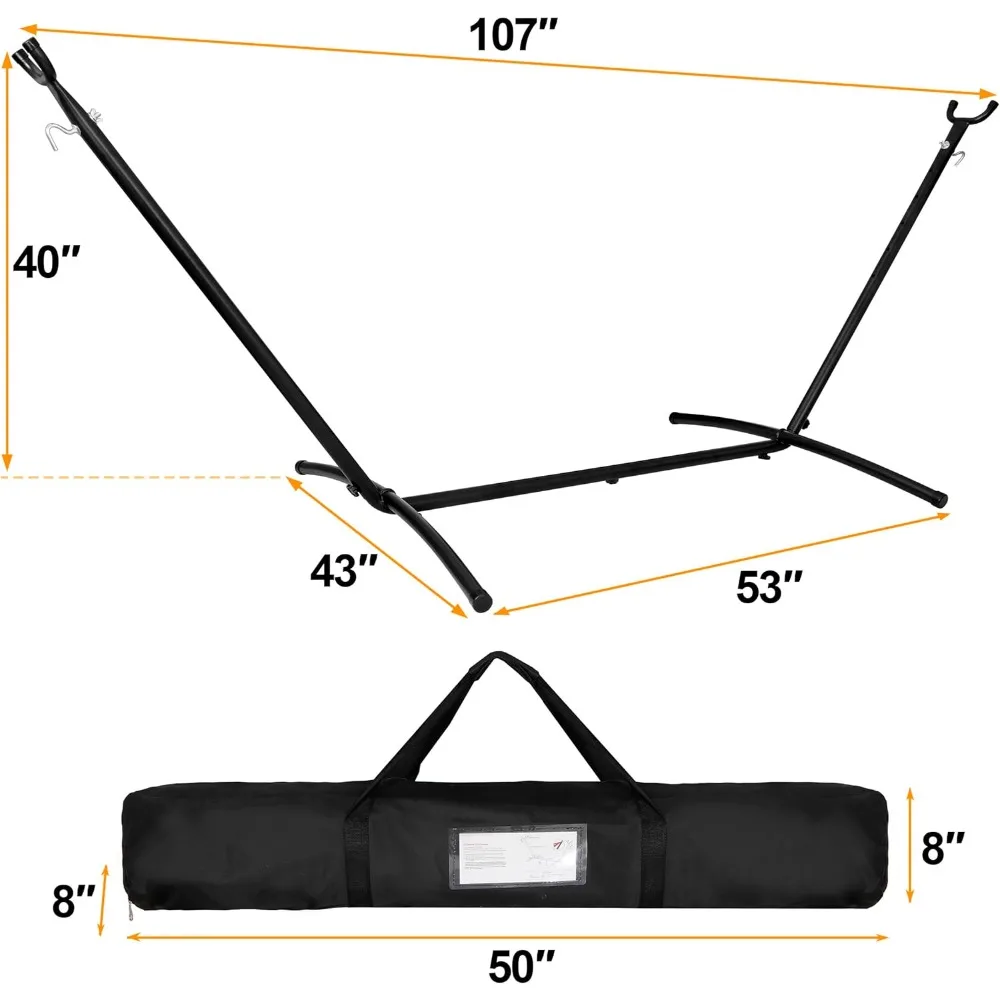
Real-World Ultralight Hammock Setups and Weight Breakdowns
To provide concrete examples of what’s achievable, here are three real-world ultralight hammock configurations with detailed component breakdowns:
Ultralight 3-Season Setup (Total: 7.3 lbs/3.3kg)
| Component | Item Example | Weight |
|---|---|---|
| Hammock | 11’ 1.2oz Ripstop | 11.5oz (326g) |
| Suspension | Dyneema Whoopie Slings + 1” Polyester Straps | 4.2oz (119g) |
| Tarp | 11’ Silpoly Hex | 9.8oz (278g) |
| Underquilt | 3/4 Length 30°F Down | 13.6oz (386g) |
| Top Insulation | 30°F Down Quilt | 19.2oz (544g) |
| Bug Protection | Integrated Bug Net | 4.5oz (128g) |
| Stakes/Guylines | Titanium Stakes + 1.5mm Dyneema | 3.2oz (91g) |
| Stuff Sacks | Various Ultralight | 2.3oz (65g) |
| TOTAL | 68.3oz (1937g) |
Super Ultralight Summer Setup (Total: 4.8 lbs/2.2kg)
| Component | Item Example | Weight |
|---|---|---|
| Hammock | 10’ 1.0oz Ripstop | 7.9oz (224g) |
| Suspension | Dyneema Suspension | 3.0oz (85g) |
| Tarp | 8.5’ DCF Diamond | 6.2oz (176g) |
| Underquilt | Summer 50°F Synthetic | 10.5oz (298g) |
| Top Insulation | 45°F Down Quilt | 14.8oz (420g) |
| Bug Protection | Head Net + Permethrin | 1.2oz (34g) |
| Stakes/Guylines | Titanium + Dyneema | 2.7oz (77g) |
| Stuff Sacks | Minimal | 1.5oz (43g) |
| TOTAL | 47.8oz (1356g) |
Winter-Capable Ultralight Setup (Total: 9.2 lbs/4.2kg)
| Component | Item Example | Weight |
|---|---|---|
| Hammock | 11’ 1.7oz Double Layer | 17.3oz (491g) |
| Suspension | Webbing with Hardware | 6.1oz (173g) |
| Tarp | 12’ Silpoly with Doors | 14.2oz (403g) |
| Underquilt | Full-Length 0°F Down | 22.5oz (638g) |
| Top Insulation | 0°F Down Quilt | 26.7oz (757g) |
| Bug Protection | Integrated Net (Summer Only) | 4.5oz (128g) |
| Stakes/Guylines | Heavy Duty Setup | 4.8oz (136g) |
| Stuff Sacks | Waterproof | 3.2oz (91g) |
| TOTAL | 99.3oz (2817g) |
These examples demonstrate how ultralight principles can be applied across different seasons and comfort requirements. The summer setup sacrifices some versatility for minimum weight, while the winter setup includes necessary components for cold-weather safety while still maintaining reasonable weight.
Frequently Asked Questions About Ultralight Hammock Backpacking
How durable are ultralight hammock materials?
Ultralight materials require more care but can be surprisingly durable with proper handling. A 1.0-1.2oz nylon hammock can last for thousands of nights if you remove sharp objects from pockets, keep it away from abrasive surfaces, and inspect it regularly for damage. DCF and specialized ultralight materials trade some durability for weight savings but remain strong in their primary stress directions.
What’s a realistic weight expectation for a complete ultralight hammock system?
A complete 3-season hammock sleep system (hammock, suspension, tarp, insulation, and bug protection) typically weighs between 5-8 pounds (2.3-3.6kg) while maintaining safety and comfort. Summer-specific setups can drop below 5 pounds (2.3kg), while winter setups may approach 9-10 pounds (4.1-4.5kg) due to insulation requirements.
How does the weight of an ultralight hammock setup compare to an ultralight tent?
A comparable ultralight hammock system typically weighs 0.5-1 pound (0.2-0.5kg) less than an ultralight tent setup with similar temperature ratings and weather protection. The weight difference becomes more significant when camping on rough terrain where tent users need more substantial sleeping pads.
What do I do if there are no trees available?
In treeless environments, options include:
– Using trekking poles with specialized hammock stands (adds 8-12oz/227-340g)
– Setting up your tarp as a ground shelter and sleeping on your underquilt
– Carrying an ultralight bivy (5-8oz/142-227g) as a backup shelter
– Using creative anchor points like vehicles, large rocks, or sturdy man-made structures
Are sleeping pads or underquilts better for ultralight hammock camping?
For true ultralight hammock camping, underquilts typically provide better warmth-to-weight performance. While a closed-cell foam pad might weigh less (6-8oz/170-227g vs. 12-14oz/340-397g for an underquilt), the superior insulation efficiency, comfort, and elimination of shifting make underquilts worth the slight weight penalty for most hammock campers.
Care and Maintenance to Maximize Gear Lifespan and Performance
Proper care of ultralight hammock gear not only extends its lifespan but also maintains optimal performance and safety. Follow these guidelines to protect your investment:
Hammock and Tarp Maintenance
- Clean with gentle hand washing using non-detergent soap when visibly dirty
- Always dry completely before storage to prevent mildew growth
- Store hammocks and tarps loosely in large cotton or mesh bags, never compressed
- Inspect stitching and high-stress points regularly for wear
- Repair small holes immediately with adhesive patch kits (0.5oz/14g) before they expand
- Apply DWR refresher to tarp surfaces annually or when water stops beading
Down Insulation Care
- Air out underquilts and top quilts daily during trips when possible
- Store uncompressed in large cotton storage sacks when not in use
- Wash only when necessary (typically once per season) using down-specific cleaner
- Restore loft after washing with proper drying and manual fluffing
- Consider professional cleaning for expensive down items
- Carry a small bottle (0.5oz/14g) of DWR spray for emergency water-resistance restoration
Field Repair Kit Components
A complete ultralight repair kit weighs just 1-2oz (28-57g) and includes:
– Tenacious Tape patches for fabric repairs
– Small needle and thread for stitching
– Spare cordage for suspension repairs
– Tiny bottle of seam sealer
– 2-3 safety pins for temporary fixes
Long-term Storage Best Practices
- Clean all components before extended storage
- Store in a cool, dry place away from direct sunlight
- Keep hammock and tarp fabrics loose and unfolded
- Hang insulation items or store in oversized bags
- Periodically check and air out gear during extended storage
By implementing these care practices, you can extend the life of ultralight gear from 2-3 years to 5+ years of regular use, making the investment in quality components more economical over time.
Resources for Further Learning and Community Engagement
The ultralight hammock community offers extensive resources for continuing education and connection with fellow enthusiasts:
Online Communities
- Hammock Forums: The largest dedicated hammock camping community with specialized ultralight sections
- r/UltralightBackpacking: Reddit community with regular hammock discussions and gear reviews
- Backpacking Light Forums: Focused on weight reduction with active hammock threads
- Facebook Ultralight Hammock Groups: Smaller communities with frequent gear exchanges
Knowledge Resources
- “The Ultimate Hang” by Derek Hansen: Comprehensive guide to hammock techniques
- “Lightweight Backpacking & Camping” edited by Ryan Jordan: Includes hammock-specific chapters
- Shug’s YouTube Channel: Detailed videos on ultralight hammock techniques and gear reviews
- Hammock Camping Videos: Visual demonstrations of setup techniques and gear comparisons
Specialized Learning Resources
- DIY Gear Making Communities: Learn to make your own ultralight hammock components
- Regional Hammock Groups: Connect with local hammockers for area-specific knowledge
- Manufacturer Workshops: Many hammock companies offer clinics and field sessions
- University Outdoor Programs: Increasingly offering hammock-specific instruction
These resources provide opportunities to deepen your understanding of ultralight hammock principles, connect with experienced practitioners, and stay current with evolving gear and techniques.
Conclusion: Embracing the Ultralight Hammock Philosophy
Ultralight hammock backpacking represents more than just a way to reduce pack weight—it’s a comprehensive approach to outdoor experience that prioritizes comfort, mobility, and environmental consciousness. By combining minimalist principles with hammock-specific techniques, you create a system that adapts to diverse environments while maintaining remarkable comfort.
The weight savings achieved through proper gear selection and multi-use strategies directly translates to greater hiking distances, reduced fatigue, and more enjoyable journeys. An ultralight hammock system allows you to access terrain that would be challenging or impossible for ground dwellers, opening new possibilities for exploration.
Remember that skills and knowledge often matter more than gear acquisition. The techniques for proper hanging, insulation management, and weather protection you’ve learned throughout this guide will serve you better than simply purchasing the lightest available equipment. Focus on developing these skills gradually through practice in controlled environments before remote adventures.
As you refine your ultralight hammock system, you’ll discover a profound sense of freedom that comes from carrying less while experiencing more. The simplicity of swinging gently between trees, protected from elements yet connected to nature, embodies what many outdoor enthusiasts seek: a harmonious balance between comfort and wilderness immersion.

